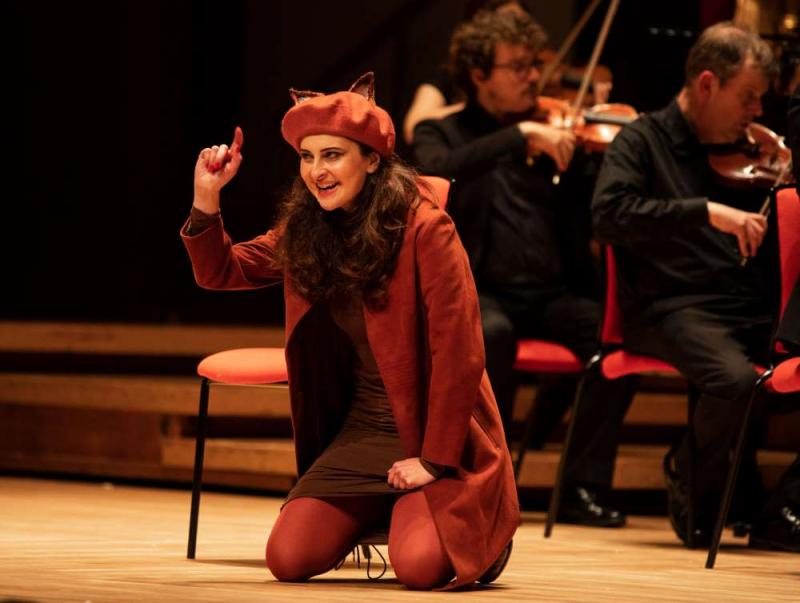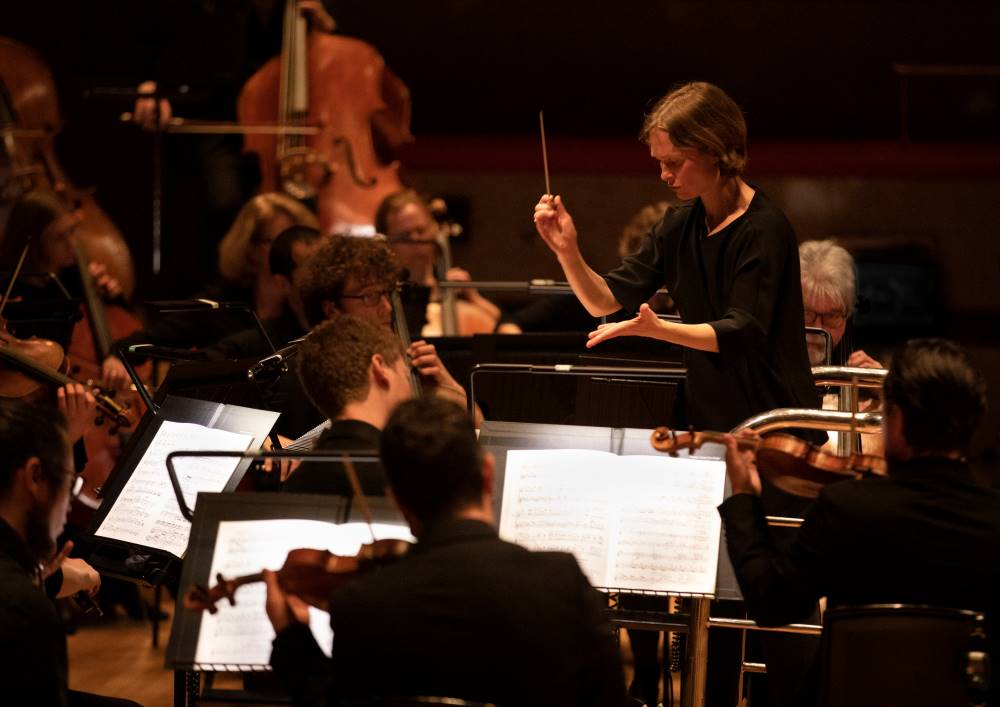The Cunning Little Vixen, CBSO, Gražinytė-Tyla, Symphony Hall Birmingham review - nature, large as life | reviews, news & interviews
The Cunning Little Vixen, CBSO, Gražinytė-Tyla, Symphony Hall Birmingham review - nature, large as life
The Cunning Little Vixen, CBSO, Gražinytė-Tyla, Symphony Hall Birmingham review - nature, large as life
Janáček's natural wonder goes large, in a supercharged concert staging

"Nature is healing," declared the social media meme, back in the early days of lockdown when humanity had temporarily retreated to focus on its banana bread. There were pictures to prove it, apparently. Dolphins sported in the canals of Venice; city gardens filled with newly emboldened songbirds. Didn’t a herd of goats colonise Llandudno at one point? Something like that, anyway.
What’s certain is that the aftermath has seen a boom in the population of operatic foxes. Vixens were sighted this summer in Longborough and Holland Park; there’s one due at ENO in February. They’re less common in the concert hall, though in many ways it’s an ideal ecological niche – allowing Janáček’s vulpine sub-genus to flourish in unsuspected ways.The overwhelming impression in this concert staging from the CBSO under Mirga Gražinytė-Tyla (pictured below) was sheer generosity.
For various practical reasons, both of the summer’s Vixens were performed with reduced orchestras, and it's easy to get used to hearing the opera as a wiry, Stravinsky-ish chamber piece. Not that Janáček can’t take it; but when you hear a full symphony orchestra in this score - freed from the pit and playing without any fear of drowning the singers (30 years on, that initial investment in Symphony Hall’s acoustics continues to pay dividends) – you feel something more. The silken heft of a full string section relocates Janáček firmly back in early 20th century central Europe, in the world of Strauss, Berg and Szymanowski. And the weight and depth of the full orchestral sonority creates its own, elemental momentum: the cycle of nature in this score has never felt quite so vast, or so inevitable.
How much of that would apply to any concert performance in this venue, and how much is due specifically to Gražinytė-Tyla, I couldn’t say, but the foreground brightness and dancing energy felt very much like her. Not that she interposed herself: with so much going on at the front of the stage, she was anything but domineering. And this was genuinely a staging rather than a stand and deliver concert performance, with a director credited (Thomas Henderson) and the cast in costume and singing from memory – entering, leaving, and getting fully inside their characters in between. Or in some case, several characters. Kitty Whately moved effortlessly between four separate roles (including the Dog and the Forester’s Wife), while William Thomas was practically a shapeshifter, vocally as well as physically: oaky and wide-grained as Harašta the poacher, tighter-toned and lugubrious as the homesick Priest.
In fact, the singing across the entire cast was consistently thrilling; with Elena Tsallagova (as Sharp-Ears) and Roland Wood (the Forester) both on blazing form. Tsallagova was coquettish and assured, every inch the force of nature and capable of soaring over Elektra-like orchestral dissonances (well, I said it got Straussian) with her voice on a blinding full beam. (A quick word for Catherine Mulroy, who embodied Tsallagova’s younger self with unnerving accuracy and – in common with the other school age performers – a bright, natural musicality). Wood was just as much of a presence: a younger Forester than we sometimes see, a real heldenbaritone with a ringing bronzed voice, whose rough cut humour rang true and who delivered his reflections on transience with a shrug and a smile: plenty of life in this (not so) old dog yet.
Well, Janáček thrives on humour, and part of the joy of this performance sprang from the way that Gražinytė-Tyla channelled that playful energy and passed it around the whole ensemble. The Woodpecker (Whately again) led the wedding of Sharp Ears and the Fox (Angela Brower, sunny and sensuous as a kind of rustic Octavian Rofrano) like an Evangelical minister surrounded by a boogying chorus; the chorus line of chickens expired in flurries of hand-thrown feathers, and the fox cubs positively stampeded on stage. The CBSO paid it back by the bucketload, with bold, bristling colours and an exuberant rhythmic verve, as well as that silky, diamond edged string sound. That makes it sound hyperactive, but Gražinytė-Tyla charged the more bittersweet moments with an intense pathos. With Janáček’s full brass section, you really felt those long, primal brass pedal-notes, and the horns, in particular, sounded gloriously ripe as the action moved indoors to the village inn.
Reservations? Well, there’s a limit to what can be done with any opera in a concert hall, and occasionally the storytelling got lost – we never quite saw how Sharp Ears makes her escape, and for all the sensual beauty of the orchestral interludes, it wouldn’t hurt to give some indication of what’s actually supposed to be happening. I’ll repeat my occasional (and general) plea for surtitles in concert performances to include at least some of the stage directions. But you’d have to have been very disengaged indeed not to have felt a pricking behind the eyes at Henderson’s final intervention – as the Forester took the hand of the little girl playing the young Vixen and led her gently offstage – or to have sensed the hope and wonder that (in this performance) radiated from even Janáček’s darkest moments. There are other ways to perform the Vixen; there have been many opportunities to see them, and – happily – there will be more in the near future. But there’s no end to nature’s capacity for renewal, and right now it feels like the same applies to this miraculous opera.
Add comment
The future of Arts Journalism
You can stop theartsdesk.com closing!
We urgently need financing to survive. Our fundraising drive has thus far raised £49,000 but we need to reach £100,000 or we will be forced to close. Please contribute here: https://gofund.me/c3f6033d
And if you can forward this information to anyone who might assist, we’d be grateful.

Subscribe to theartsdesk.com
Thank you for continuing to read our work on theartsdesk.com. For unlimited access to every article in its entirety, including our archive of more than 15,000 pieces, we're asking for £5 per month or £40 per year. We feel it's a very good deal, and hope you do too.
To take a subscription now simply click here.
And if you're looking for that extra gift for a friend or family member, why not treat them to a theartsdesk.com gift subscription?
more Opera
 Orpheus and Eurydice, Opera Queensland/SCO, Edinburgh International Festival 2025 review - dazzling, but distracting
Eye-popping acrobatics don’t always assist in Gluck’s quest for operatic truth
Orpheus and Eurydice, Opera Queensland/SCO, Edinburgh International Festival 2025 review - dazzling, but distracting
Eye-popping acrobatics don’t always assist in Gluck’s quest for operatic truth
 MARS, Irish National Opera review - silly space oddity with fun stretches
Cast, orchestra and production give Jennifer Walshe’s bold collage their all
MARS, Irish National Opera review - silly space oddity with fun stretches
Cast, orchestra and production give Jennifer Walshe’s bold collage their all
 Káťa Kabanová, Glyndebourne review - emotional concentration in a salle modulable
Janáček superbly done through or in spite of the symbolism
Káťa Kabanová, Glyndebourne review - emotional concentration in a salle modulable
Janáček superbly done through or in spite of the symbolism
 Buxton International Festival 2025 review - a lavish offering of smaller-scale work
Allison Cook stands out in a fascinating integrated double bill of Bernstein and Poulenc
Buxton International Festival 2025 review - a lavish offering of smaller-scale work
Allison Cook stands out in a fascinating integrated double bill of Bernstein and Poulenc
 Tosca, Clonter Opera review - beauty and integrity in miniature
Happy surprises and a convincing interpretation of Puccini for today
Tosca, Clonter Opera review - beauty and integrity in miniature
Happy surprises and a convincing interpretation of Puccini for today
 Hamlet, Buxton International Festival review - how to re-imagine re-imagined Shakespeare
Music comes first in very 19th century, very Romantic, very French operatic creation
Hamlet, Buxton International Festival review - how to re-imagine re-imagined Shakespeare
Music comes first in very 19th century, very Romantic, very French operatic creation
 Falstaff, Glyndebourne review - knockabout and nostalgia in postwar Windsor
A fat knight to remember, and snappy stagecraft, overcome some tedious waits
Falstaff, Glyndebourne review - knockabout and nostalgia in postwar Windsor
A fat knight to remember, and snappy stagecraft, overcome some tedious waits
 Salome, LSO, Pappano, Barbican review - a partnership in a million
Asmik Grigorian is vocal perfection in league with a great conductor and orchestra
Salome, LSO, Pappano, Barbican review - a partnership in a million
Asmik Grigorian is vocal perfection in league with a great conductor and orchestra
 Semele, Royal Opera review - unholy smoke
Style comes and goes in a justifiably dark treatment of Handelian myth
Semele, Royal Opera review - unholy smoke
Style comes and goes in a justifiably dark treatment of Handelian myth
 Le nozze di Figaro, Glyndebourne review - perceptive humanity in period setting
Mostly glorious cast, sharp ideas, fussy conducting
Le nozze di Figaro, Glyndebourne review - perceptive humanity in period setting
Mostly glorious cast, sharp ideas, fussy conducting
 Fidelio, Garsington Opera review - a battle of sunshine and shadows
Intimacy yields to spectacle as Beethoven's light of freedom triumphs
Fidelio, Garsington Opera review - a battle of sunshine and shadows
Intimacy yields to spectacle as Beethoven's light of freedom triumphs
 Dangerous Matter, RNCM, Manchester review - opera meets science in an 18th century tale
Big doses of history and didaction are injected into 50 minutes of music theatre
Dangerous Matter, RNCM, Manchester review - opera meets science in an 18th century tale
Big doses of history and didaction are injected into 50 minutes of music theatre

Comments
seeing the work for the first